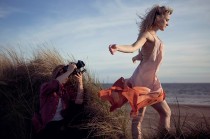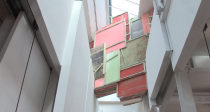Across its dance programme, the IETM emphasises the impact of contemporary processes on a variety of more traditional forms. Whether it is Plan B, with their connection to Highland dance, or Dance Ihayami who are known for slipping a Celtic atmosphere into their reading of classical Indian dance, Scotland is a ferment of cross-cultural collaboration and imaginative mash-ups of style and genre.
Nevertheless, “pure” contemporary, in the form of restless experimentation and a connection to the greats of the twentieth century, is equally well represented. Clea Wallis was originally a painter, but spent eight months with the legendary Pina Bausch company before hooking up with Anne Duden to found Dudendance. Their Spaceman 2 is an iteration of a solo piece by Paul Rous, and draws influence from both manga animation and NASA footage. Like Rambert’s recent foray into natural selection, Spaceman 2 is an example of how the arts are increasingly engaging with scientific thought: Rous morphs his physical appearance as if desperately trying to discover a new way of communication that does not rely on sound or words.
Anna Krzystek was once a member of the Glasgow core of Dudendance: in recent years, she has been following an idiosyncratic path between Live Art and choreography. Figure This, her IETM entry, studies the body pushed to extremes, and features an original sound score by Tom Murray alongside video footage. Kryzstek’s preoccupations with time, space and the human condition make her choreography deliberately bracing, encouraging an intellectual approach from the audience and asking tough questions both about human potential and the nature of dance itself.
Janice Parker‘s Private Dancer is another work that first appeared under the aegis of Dance Base during the Edinburgh Fringe. It is an astonishing piece: emotional rather than abstract, it happens within a set that redefines the space that it occupies, and introduces the audience to a series of intimate solos and group dances. Somewhere between installation and meditation, it has been described by Mark Harding of the Shimmy as “the most significant show” of the 2010 Fringe.
That the IETM covers so much ground, yet fails to exhaust the fecundity of the Scottish scene, is a testament to Caledonian creativity and energy. There are, of course, other companies not represented during he IETM, yet the cross-section on show gives a flavour of both quality and diversity.














Comments